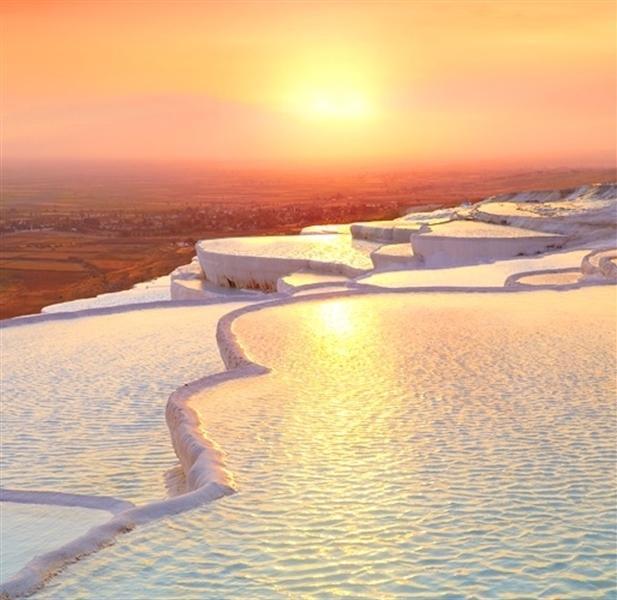
In terms of a spa, I was sure it had no match in all of Turkey. Cleopatra’s Pool, a miracle of nature in which thermal waters gently course over the ruins of columns at the ancient city of Hierapolis, transports the visitor back to time immemorial. The therapeutic spring waters that bubble to the surface in this region were a source of life for Hierapolis, one of the most prominent centers of health in antiquity. Large or small, the city’s many public baths served guests all day long, boosting the city’s fame. Today, the large public bath in the heart of the city has become the Hierapolis Museum.
Let’s embark now on a journey of discovery, following the waters that have blessed Pamukkale, Hierapolis and other places in Denizli, in Turkey’s southwest, with splendid civilization from ancient times right up to the present.
Romantic white, therapeutic red
Just a few minutes’ walk from Hierapolis, which welcomes over a million visitors a year, lies a geological wonder: Pamukkale and its majestic snow-white travertine pools. While it is prohibited to tread on the tiny pools, there’s nothing to stop one from floating high above them with a glider. Çökelez Dağı, a mountain by Pamukkale that is poised to overtake Babadağ on Turkey’s southwest coast as the country’s gliding capital, is at an ideal altitude for a flight.
 Authorities have also taken other precautions to preserve Pamukkale’s delicate travertines, moving all hotels to Karahayıt. In contrast to Pamukkale’s white waters, the therapeutic waters that rise to the surface at Karahayıt’s travertines are red due to dozens of minerals and a high concentration of iron ions.
Authorities have also taken other precautions to preserve Pamukkale’s delicate travertines, moving all hotels to Karahayıt. In contrast to Pamukkale’s white waters, the therapeutic waters that rise to the surface at Karahayıt’s travertines are red due to dozens of minerals and a high concentration of iron ions.
Following the trail of the waters is a good way of getting to know Denizli and the Aegean mysteries it harbors. In Denizli’s city center, there are two beautiful parks, İncilipınar and Çamlık, which are adorned with lakes, fountains and tiny waterfalls. The viewing castle in the city’s exclusive Çamlık district is a perfect spot for gazing down on Denizli from above. But to get to know the city really well, a few hours’ stroll is in order. Bayramyeri, the city’s historic center, is a good place to start. The Germiyanoğulları Hamam immediately adjacent to the Ethnography Museum is exactly 763 years old. A little further on, the historic market in the castle is an old-time bazaar where coppersmiths, woodworking masters, jewelers and saddlers keep alive traditional handicrafts. If you happen to be there around noon, the aromas wafting up from the shops are sure to whet your appetite, and there’s no leaving without trying the roast lamb known as “Denizli kebab,” which is cooked for hours in special stone ovens and infused with a medley of vegetables and set on wedges of hot “pide.” Hüseyin Manisalı, who has spent the last 45 years preparing this original kebab, attributes the flavor of the meat to the fact that it is cooked in the embers of the “sakız” tree (Liquidambar orientalis). Elsewhere, the palm-lined Atatürk Boulevard is abuzz the whole day with its department stores and shopping centers. And the area around Çınar (Plane Tree) Square, which is chock full of cinemas, theaters, cafes and restaurants, is a popular hangout with Pamukkale University students.
Worthy of sultans
It’s not difficult to find gift items in Denizli, which has become one of Turkey’s leading centers for textile manufacturing in recent years. You can find handkerchiefs embroidered with roosters, Buldan cloth, Tavas embroidery and lace, as well as colorful printed fabrics, by the thousands in Babadağlılar Han on İstasyon Avenue, one of the city’s unique venues. But if you’re not satisfied with the variety offered by this 10-story “han,” then make a stop at Buldan itself, whose fine hand-woven fabrics are made on wooden looms that once spun out garments for Ottoman-era pashas and sultans. Without question, you’ll feel like you’ve gone back in time as you stroll among Buldan’s quintessentially Anatolian houses.
 Another Denizli icon is the rooster. Officially registered as a cultural asset in 2004, the Denizli rooster is famous for its vivid feathers and long-winded crowing. According to Mustafa Ünal, an agricultural engineer who is responsible for the preservation of the Denizli rooster, the bird can crow without interruption for up to 25-30 seconds.
Another Denizli icon is the rooster. Officially registered as a cultural asset in 2004, the Denizli rooster is famous for its vivid feathers and long-winded crowing. According to Mustafa Ünal, an agricultural engineer who is responsible for the preservation of the Denizli rooster, the bird can crow without interruption for up to 25-30 seconds.
But the rooster is not the only bird to see in Denizli, whose wetlands, which boast excellent observation points, provide a refuge for over 250 species. Lake Işıklı at Çivril; Acı Göl, a brackish lake at Çardak; and Lake Süleymanlı near Buldan are suitable for botanical walks and bird-watching year round.
Besides rare species like the imperial eagle, black vulture, great falcon, great bustard and barn owl, a significant number of other species also inhabit the Denizli region, according to birder and Denizli Photographers Club member Ümit Özgür, including the Krüper’s nuthatch, white-throated robin, Cretzschmar’s bunting and Rüppell’s warbler.
There is a national park as well, which is famous for its rich variety of animal species. Elsewhere, Honaz Dağı, a mountain that forms the highest point in the Aegean region at 2,528 meters, has also hosted the World Air Games. And finally, the waterfalls nearby Denizli will also please nature buffs: Güney (South) Falls, an official natural monument, are 8 kilometers from the town of the same name, while Gümüşsu, where the waters fall from a height of 30 meters, are east of Çivril.